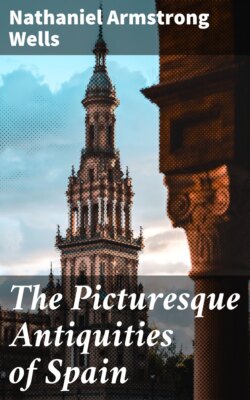Читать книгу The Picturesque Antiquities of Spain - Nathaniel Armstrong Wells - Страница 16
На сайте Литреса книга снята с продажи.
ARRIVAL AT BURGOS. CATHEDRAL.
ОглавлениеBurgos.
The chain of the Lower Pyrenees, after the ascent from the French side, and a two days' journey of alternate mountain and valley, terminates on the Spanish side at almost its highest level. A gentle descent leads to the plain of Vitoria; and, after leaving behind the fresh-looking, well-farmed environs of that town, there remains a rather monotonous day's journey across the bare plains of Castile, only varied by the passage through a gorge of about a mile in extent, called the Pass of Pancorbo, throughout which the road is flanked on either side by a perpendicular rock of from six to eight hundred feet elevation. The ancient capital of Castile is visible from a considerable distance, when approached in this direction; being easily recognised by the spires of its cathedral, and by the citadel placed on an eminence, which forms a link of a chain of hills crossing the route at this spot.
The extent of Burgos bears a very inadequate proportion to the idea formed of it by strangers, derived from its former importance and renown. It is composed of five or six narrow streets, winding round the back of an irregularly shaped colonnaded plaza. The whole occupies a narrow space, comprised between the river Arlançon, and the almost circular hill of scarcely a mile in circumference, (on which stands the citadel) and covers altogether about double the extent of Windsor Castle.
The city has received a sort of modern facing, consisting of a row of regularly built white houses, which turn their backs to the Plaza, and front the river; uniting at one extremity with an ancient gateway, which, facing the principal bridge, must originally have stood slightly in advance of the town, to which it formed a very characteristic entrance. It is a quadrangular edifice, pierced with a low semicircular arch. The arch is flanked on the river front by small circular turrets, and surmounted by seven niches, containing statues of magistrates, kings, and heroes; while over these, in a centre niche, stands a semicolossal statue of the Virgin, from which the monument derives its title of "Arco de Santa Maria." Another arch, but totally simple, situated at the other extremity of the new buildings, faces another bridge; and this, with that of Santa Maria, and a third, placed halfway between them, leading to the Plaza, form the three entrances to the city on the river side.
